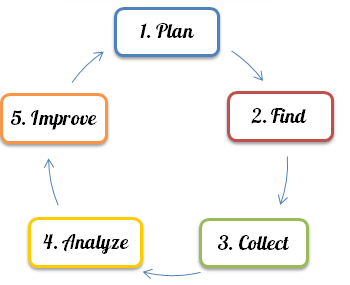Currie Management Consultants, Inc. is featuring a new two-day seminar, offered at The Currie Training Center in Worcester, Massachusetts: Benchmarking and The Currie Financial Model.
If you’re a member of a Currie Management Consultants, Inc. Best Practices Group, you’ve likely heard Bob Currie lecture on the importance of benchmarking. A Benchmark is defined as a standard against which the performance of a company can be measured. Historically, benchmarking became widely recognized as an important business practice decades ago. In the 1970s companies began to move from the reverse engineering process towards the competitive benchmark process, when engaged in the analysis of enterprise performance. From that point, benchmarking became a required activity for all high performing companies, or ones that strived to become better performers.
Bjorn Andersen & Per-Gautte Petterson, in their work The Benchmarking Handbook, have created the Five Phase Benchmarking Wheel to demonstrate the process. This procedure demonstrates a methodology of working towards continuous improvement in a business, as it relates to benchmarking.
In the distribution of industrial equipment, consistent tracking and analysis of financial and other activities enables dealer principals and executives to stay on top of their performance results each and every day. Some results are short-term (employee productivity measures, rental multiple, and the like) and should be reviewed on a regular basis in order to discover and implement tactical variations. Others measures are more long term, such as Debt to Equity, ROA, and Absorption, and indicate the critical liquidity results of the business, thus allowing the executive team to manage capital effectively and create long-term strategy. The results of all of these financial measures provide us with the profile of a well-run industrial equipment distribution company.
Industry standards are another critical factor to understand when engaging in the benchmarking process. The industry standards for hundreds of Key Performance Indicators for the Industrial Equipment Dealers are well established, and over the past couple of decades have been developed into the Currie Financial Model©. The Currie Model is a diagnostic tool that, when combined with total industry comparisons, is another powerful indicator of the health of your business as it compares to others within the industry. The Currie Financial Model is widely accepted throughout all Industrial Equipment industries. Analysis of the industry’s highest performers, over many years of study, have been the basis for The Model. The Currie Team has developed detailed financial benchmarks for more than a dozen industrial equipment distribution companies which are involved in different product offerings. One of Bob Currie’s most famous quotes succinctly describes the purpose of the Currie Model: “What does it look like when it’s right?”
It is necessary to address some of the current attitudes and practices that the Currie team is observing from equipment distributors that we currently work with. Many distribution companies that Currie works with are highly engaged in the benchmarking process, and tirelessly tailor their company’s reporting system in order to accommodate the requests for data that they receive from Currie Management Consultants, Inc., for the quarterly Currie Financial Composite, or other industry or dealership reports. These companies are committed to accurate and timely reporting, and that is a discipline which greatly benefits these companies, as their results are always readily accessible. Other clients are not quite as committed to the process. Many times we see a distribution company struggle to produce the data that is necessary for inclusion in one of the above mentioned benchmarking processes. Perhaps the company’s reporting system is not accommodating to the data input requests, the business is in a state of change and there is not enough manpower to dedicate to detailed reporting, or perhaps the executive team has not quite “bought in” to the industry benchmarking practice. For those businesses, the Currie team strongly urges the owners and executives to make a renewed commitment to engaging in the critically important process of providing complete and accurate reporting, on a regular basis. There are powerful tools at the disposal of all Currie clients. The dedication that is required will most definitely pay off!
Financial Benchmarking is the cornerstone of a sound company. And the numbers that the executives and managers are exposed to in the Currie Financial Composite are meant to identify areas of the business that need further attention. Also, identifying areas that are running well can help us: think about what’s going on, and think about how to apply some of those specific practices to an area of the business that is struggling.
Finally, a quote from Robin Currie: “Remember, numbers tell a story. What are these numbers telling us? What is the story that that is unfolding based upon the results of your Currie Financial Composite or Individual Company Analysis? The numbers, and the stories that accompany the analysis, are not meant to give us answers, rather they are designed to prompt us to enter into a Socratic discussion. Instead of providing answers, let the numbers, and the empirical results of your data analysis, provide questions.”

